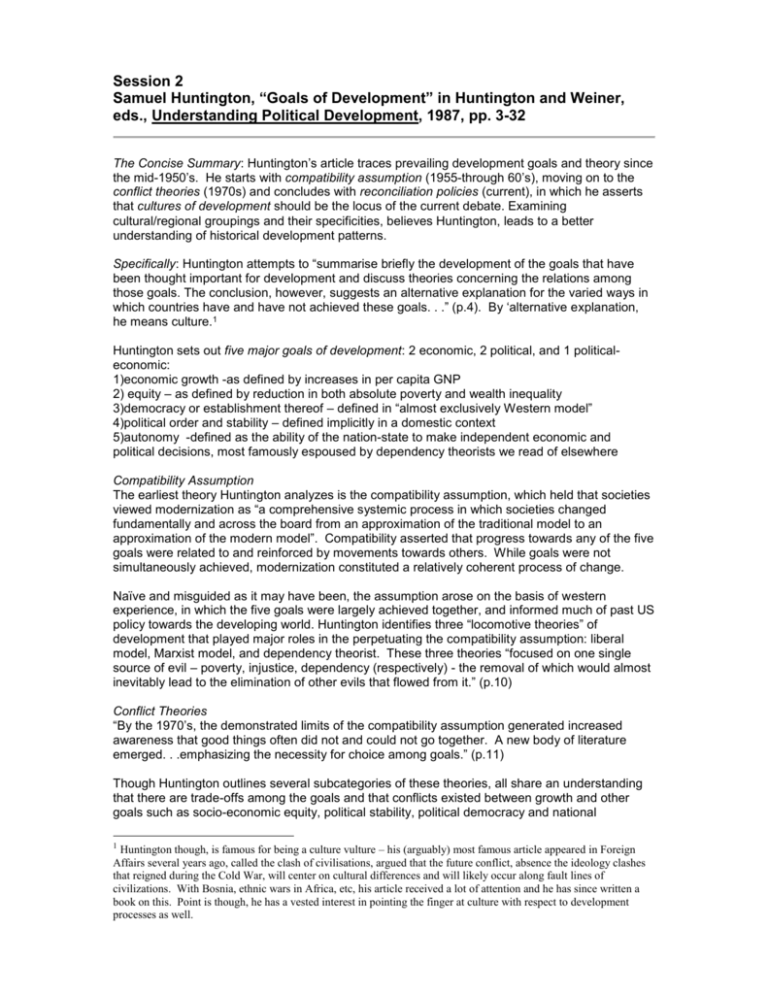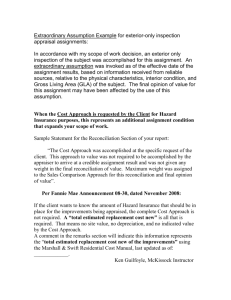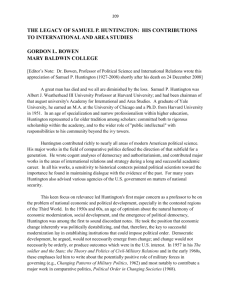The Goals of Development
advertisement

Session 2 Samuel Huntington, “Goals of Development” in Huntington and Weiner, eds., Understanding Political Development, 1987, pp. 3-32 The Concise Summary: Huntington’s article traces prevailing development goals and theory since the mid-1950’s. He starts with compatibility assumption (1955-through 60’s), moving on to the conflict theories (1970s) and concludes with reconciliation policies (current), in which he asserts that cultures of development should be the locus of the current debate. Examining cultural/regional groupings and their specificities, believes Huntington, leads to a better understanding of historical development patterns. Specifically: Huntington attempts to “summarise briefly the development of the goals that have been thought important for development and discuss theories concerning the relations among those goals. The conclusion, however, suggests an alternative explanation for the varied ways in which countries have and have not achieved these goals. . .” (p.4). By ‘alternative explanation, he means culture.1 Huntington sets out five major goals of development: 2 economic, 2 political, and 1 politicaleconomic: 1)economic growth -as defined by increases in per capita GNP 2) equity – as defined by reduction in both absolute poverty and wealth inequality 3)democracy or establishment thereof – defined in “almost exclusively Western model” 4)political order and stability – defined implicitly in a domestic context 5)autonomy -defined as the ability of the nation-state to make independent economic and political decisions, most famously espoused by dependency theorists we read of elsewhere Compatibility Assumption The earliest theory Huntington analyzes is the compatibility assumption, which held that societies viewed modernization as “a comprehensive systemic process in which societies changed fundamentally and across the board from an approximation of the traditional model to an approximation of the modern model”. Compatibility asserted that progress towards any of the five goals were related to and reinforced by movements towards others. While goals were not simultaneously achieved, modernization constituted a relatively coherent process of change. Naïve and misguided as it may have been, the assumption arose on the basis of western experience, in which the five goals were largely achieved together, and informed much of past US policy towards the developing world. Huntington identifies three “locomotive theories” of development that played major roles in the perpetuating the compatibility assumption: liberal model, Marxist model, and dependency theorist. These three theories “focused on one single source of evil – poverty, injustice, dependency (respectively) - the removal of which would almost inevitably lead to the elimination of other evils that flowed from it.” (p.10) Conflict Theories “By the 1970’s, the demonstrated limits of the compatibility assumption generated increased awareness that good things often did not and could not go together. A new body of literature emerged. . .emphasizing the necessity for choice among goals.” (p.11) Though Huntington outlines several subcategories of these theories, all share an understanding that there are trade-offs among the goals and that conflicts existed between growth and other goals such as socio-economic equity, political stability, political democracy and national Huntington though, is famous for being a culture vulture – his (arguably) most famous article appeared in Foreign Affairs several years ago, called the clash of civilisations, argued that the future conflict, absence the ideology clashes that reigned during the Cold War, will center on cultural differences and will likely occur along fault lines of civilizations. With Bosnia, ethnic wars in Africa, etc, his article received a lot of attention and he has since written a book on this. Point is though, he has a vested interest in pointing the finger at culture with respect to development processes as well. 1 autonomy. Such theories were supported by Kuznets curve (equality is higher in poor and rich countries, but much higher in between, generating a n-shaped growth-equality curve), and Brazilian/Chinese models of growth, which sacrifice some goals (equity/democracy) for others (growth). Other important components of the conflict theories held that: Creation of democratic political system in countries with low social mobilization (thus participation) would lead to less, not more equality Democratic systems were generally unable to achieve redistribution of assets A high level of instability may be necessary to achieve a minimal degree of equity in the short-run (radical conflict theorists) “rate/level paradox” : a high level of two variables (e.g. growth and democracy) may be associated with each other, but a high rate of increase in one of those variables may be associated with no rate of increase or even decrease in the other variable. Reconciliation Policies The third body of literature was “devoted to exploring the ways in which development goals could be reconciled with one another. Assumed compatibility, in short, was undermined by the perceived pervasiveness of conflict, which in turn gave birth to the psychological and physical desire to resolve those conflicts. Emphasis on the cruel need for choice was replaced by emphasis on the urgent need for reconciliation.” (p. 18) Reconciliation focused on sequencing, structures, and strategies. Reconciliation policies generally agree upon a sequencing priority for political ends (national unity should be emphasized before governmental authority before political equality) but are unsure on whether to focus on equity or growth as an economic priority. Certain institutional structures (such as two party system or limited state role in economy) may facilitate the reconciliation of the goals. And strategies such as extensive education investment, promotion of labor-intensive industries and early redistribution of economic assets are also more likely to help achieve development goals. Reconciliation however, tends to “involve either political scientists attempting to reconcile stability and democracy or economists attempting to reconcile equity and growth. Rarer were crossdisciplinary effort to show how the achievement of political goals might be reconciled with the achievement of political ones.” (p.20-21). Can democracy, growth and equity be reconciled? The Japan model would have us believe that it is possible. But could the Japan model be reproduced outside Japan? This leads into Huntington’s alternative (and admittedly amorphous) assertion that culture explains such differing patterns of development. “To explain why reconciliation, like harmony and conflict, is not universal, one is forced back to things unique to particular countries. These include natural resources, geographical location, character of the population, and of course, historical experience. In terms of explaining different patterns of political and economic development however, a central independent variable is culture – that is subjective attitudes, beliefs, values prevalent among the dominant groups in the society. “ (p.22) Huntington fits the world into nine cultural groupings which encompasses 85% of the world’s population 1)Nordic 2)Latin 3)Arab 4)Slavic 5)Indian 6)Sinic 7) Japanese 8)Malay 9) African. Caveats notwithstanding, these groupings contain societies that have developed in very different ways. Comparing patterns of development worldwide, it may be difficult to understand why Ghana and South Korea, similar countries by most measures in the early 60s, are so different today. If one compared regional/cultural patterns of development however, the difference appears to make more sense. Huntington proposes that the goals of development (which the 3 major theories espoused) are Western-centric, and may not accord with another culture’s image of an ideal society. Perhaps, Huntington tentatively asserts, “the time has come to change the model, to develop models of a modern Islamic, Confucian or Hindu society that would be more relevant to countries where those cultures prevail.” (p.25). Modernization, Huntington concludes, is different from Westernization, and indigenous cultures are assuming increasing importance in shaping development of different societies. “If the study of development leads back to a major focus on culture and the differences among major cultural traditions, then the time is perhaps appropriate for closer links between comparative politics scholars (developmentalist subbranch)and area specialists. . . .[S]urely a primary place has to be accorded the comparative analysis of culture, how and why it develops, how it is transmitted, what patterns it forms, how its various dimensions can be defined and measured, and how and under what circumstances it changes.” (p. 27-28).








